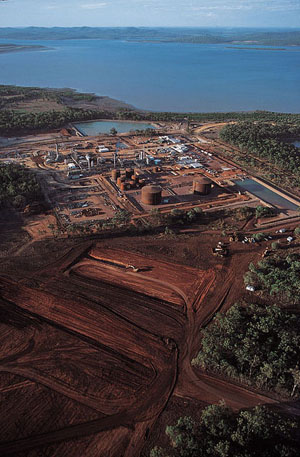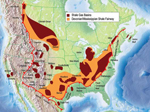Bigger Greenhouse Gas Footprint from Fracking
Study: Shale gas by fracking more dangerous than conventional gas
By Lynn Herrmann
Digital Journal
ITHACA – A new study reveals that shale gas, the product of a highly controversial extraction method called hydraulic fracturing, brings with it a greater greenhouse gas impact than conventional oil, gas, and coal over a 20-year period.
In the study, Methane and the Greenhouse-Gas Footprint of Natural Gas from Shale Formations (pdf), a group of scientists led by Robert Howarth from Cornell University raise the question of logic behind the use of natural gas derived from shale formations. They note the process of hydraulic fracturing, or fracking, to obtain shale gas leads to “fugitive emissions” of methane gas, a potent greenhouse gas (GHG). According to the study,
Natural gas is composed largely of methane, and 3.6% to 7.9% of the methane from shale-gas production escapes to the atmosphere in venting and leaks over the life-time of a well. These methane emissions are at least 30% more than and perhaps more than twice as great as those from conventional gas.
The team of scientists based their research on technical data of greenhouse gas emissions from the oil and gas industry, and from a report by the General Accountability Office (GAO) on natural gas losses on federal lands. Methane, a powerful greenhouse gas, is a potentially greater contributor to global warming than is carbon dioxide, especially during the first few decades after its emissions. The study notes that
Methane contributes substantially to the greenhouse gas footprint of shale gas on shorter time scales, dominating it on a 20-year time horizon.
During this time frame, the GHG footprint of shale gas is 22% to 43% greater than that of conventional gas. Even on the 100-year time scale, and with methane’s diminished effect after 20 years, the GHG footprint for shale gas is still 14% to 19% greater than is that of conventional gas. Little is known of the GHG footprint of shale gas and while many have expressed concern over the relatively new industry, it has remained under the radar of study or scrutiny.
Because of that lack of oversight, the fracking process has led to numerous complaints from residents located near fracking drill sites who state their drinking water supplies have been extremely contaminated by the process.
The fracking process involves large volumes of highly pressurized water forced into shale formations to fracture and re-fracture them, thereby releasing the shale gas. This method creates a flow-back, a behavior where s substantial amount of the injected water returns to the surface, from the first days to weeks afterward, carrying with it large quantities of methane.
After the fracking process and completion of the well, additional methane gas escapes into the atmosphere from routine venting and equipment leaks. A typical gas well was anywhere from 55 to 150 connections to various pieces of equipment, including meters, dehydrators, heaters, vapor-recovery apparatus and compressors.
Many of these pieces of equipment have to potential of leaking and many pressure relief valves are specifically designed to vent gas. The GAO has stated that 0.3% to 1.9% of a gas well’s lifetime production is lost to these routine venting and equipment leaks.
These figures do not include accidents or emergency vents, and as such, are conservative estimates, the study notes. Other losses from both shale and conventional gas occur during processing, transport, storage, and distribution.
The study factors in pipeline leakage by measuring the volume of gas at the wellhead and the amount actually purchased and used at the consumption end. On a global scale, this method estimates 2.5% to 10% total pipeline leakage, although the higher figure is based on improperly maintained pipelines in Russia during the Soviet collapse. Those pipeline leakages are now far less.
The report also notes there is little public information available from the gas industry on lost and unaccounted for gas, but data for Texas reveals it averaged 2.3% in 2000 and 4.9% in 2007. Although Texas passed legislation proposing a hard cap of 5% for lost and unaccounted for gas, heavy pressure from the industry forced it to be dropped.
A ProPublica report in January [2011] noted that the Environmental Protection Agency’s estimates of fugitive emissions from the fracking process were 9,000 times higher than what it had previously estimated.
In conclusion, the Howarth study notes that
Given the importance of methane in global warming, these emissions deserve far greater study than has occurred in the past. We urge both more direct measurements and refined accounting to better quantify lost and unaccounted for gas.
It also recommends a revision to carbon-trading markets that currently under-value methane’s greenhouse warming effects based on a 100-year time horizon as well as using outdated global warming potentials of methane, stating
This should be corrected, and the full GHG footprint of unconventional gas should be sued in planning for alternative energy futures that adequately consider global climate change.
Source: Digital Journal








Comments
Bigger Greenhouse Gas Footprint from Fracking — No Comments